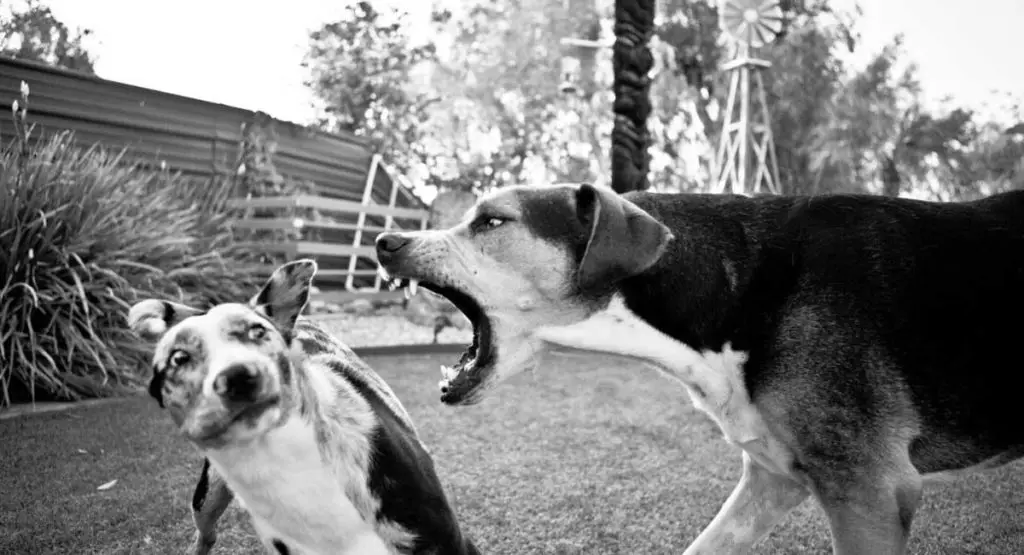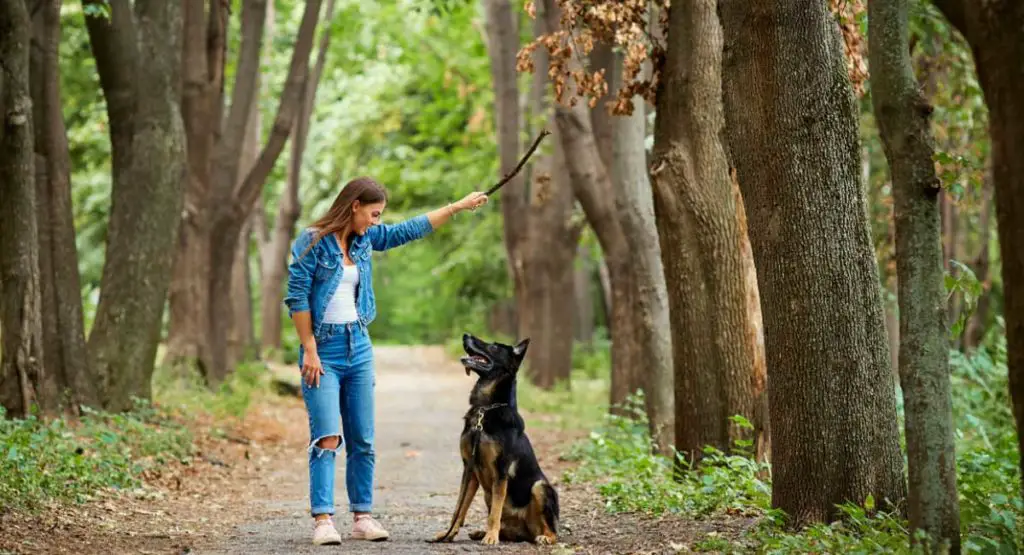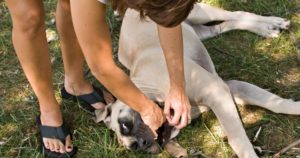Taking your dog for a walk is very healthy for both humans and beloved pets. When you’re walking your dog, both of you get in some much-needed exercise to help you stay fit and healthy. Walking your pet is also good for reducing stress, tension, anxiety, and built-up frustration.
But you can only get all of these good benefits from dog walks if your pooch is properly trained. Taking an untrained dog on walks can be a lot of hard work, which makes it difficult to enjoy. One of the most common frustrations while taking a dog for a walk is barking.
It can be quite tough to hold onto a dog that wants to lunge and bark at other dogs, and the noise of all the dogs in your neighborhood starting to bark back at your own dog can be embarrassing.
If you’re having a tough time keeping your dog in check on walks, or if you’re tired of returning home with a ring in your ears and sore hands from all the tugging, then it’s time for you to train your dog to stop barking.

Why Do Dogs Bark at Other Dogs on a Walk?
Dogs bark for all sorts of reasons. One of the most common reasons your dog might bark is that they notice something strange that causes fear. They see something strange in their home territory and instinctively need to alert their family as a means of protecting themselves and their pack.
Dogs that bark while on walks can react this way for other reasons too. Some dogs might bark out of curiosity, while others might bark because they feel playful or excited and want to greet the other dogs and get a reaction from them.
Most dogs do, however, bark out of fear while taking walks. This is because their fight or flight instinct kicks in, and since they can’t flee due to the leash, the fight reaction is all that they can do. They’ll instinctively start barking aggressively at other dogs or humans as a warning to keep away from them.
Dogs don’t just feel fear when they’re out on walks. When you walk directly up to other dogs, this behavior can be seen as rude and aggressive, even to your own dog. For example, when you walk on a footpath with your dog and directly approach someone else, you might unwittingly lure out a reaction because your dog interprets your behavior as aggressive.
What is Reactivity?
When you start doing research on the best way to train your dog, you’ll probably come across the term “reactivity.” Reactivity is a term that’s used by dog trainers to describe dogs that easily act aggressive or fearful when they’re placed in unfamiliar or uncomfortable situations.
All dogs can be reactive and will react in an attempt to protect themselves in the right situation. But reactive dogs tend to overreact and are easily provoked.
Behaviors like barking, running away, growling, and even lunging or attacking is very common for these dogs whenever they feel fear or are exposed to new environments or situations. These dogs are more stressed out compared to other dogs and might also show other behavioral issues, such as separation anxiety.
While most dogs that bark while on walks are reactive or fearful of their surroundings, there are some dogs that are an exception to this rule. Some might simply feel so excited about going outside or seeing other dogs that they can’t stand it, and start lunging and barking immediately.
Is Your Dog Aggressive?
Just because your dog is barking at others doesn’t mean that it’s aggressive. Some dogs bark as a warning to chase other dogs away, but the moment the other dog comes too close or the gate opens, the dog will flee. Other dogs that feel afraid might start to attack as a way to defend themselves, and this can’t be seen as aggression either, but rather self-preservation.
Some dogs will bark at other dogs because they’re excited to greet them and play with the strangers they see on the walk. This over-excitement can, however, flow over into aggression if the dog’s excitement gets out of control.
Sadly, some dogs are aggressive. They might bark and lunge to provoke a fight, or will blindly start attacking other dogs the moment they feel a hint of insecurity or aggression from them. Aggressive dogs should always be kept on a leash and should be walked by someone who’s physically strong enough to keep the dog under control.
Why Does Your Dog Only Bark at Some Dogs on a Walk?
While you’re walking your dog, you might notice that it’s only barking at some dogs and not others. Strangely enough, this situation probably doesn’t have anything to do with the amount of aggression the other dog is showing.
This situation is usually referred to as trigger stacking. This happens when your dog keeps his cool and excitement in check while encountering other dogs on a walk, but can suddenly no longer hold it all back. The overstimulation of the walk suddenly reaches a breaking point and your canine will start barking at other dogs.
Is it Okay to Let Your Dog Bark at Other Dogs on a Walk?
It’s normal for dogs to bark at other dogs while on walks, but it isn’t an ideal situation. Barking can be very frustrating on walks because your dog will continuously stop to bark at every dog it passes by. You and the other pet owner will need to constantly tug and drag the dogs apart, which can be exhausting.
Barking dogs can also be disruptive in the neighborhood. The moment two dogs start barking reactively, they will instill curiosity and fear in the other dogs in the environment, which can cause a very loud barking frenzy.
Allowing your dog to bark all the time can also be dangerous should you encounter an aggressive, reactive dog while walking your friendly but curious puppy. It’s much better to teach your dog not to bark at other dogs while on walks.
If the Dog You’re Walking is Barking, What Should You Do?
It’s important to realize that your dog isn’t going to stop barking at other dogs overnight. Lots of training and patience will be required before your dog will effectively stop barking at other dogs. Here’s a quick look at the best things to do to help your pet overcome this annoying habit.
Walking Strategies to Avoid Barking Behaviors
Finding the right walking strategy is an ideal place to start while you’re still teaching your dog to stop barking. Walking strategies involve minimizing the likelihood of your dog engaging in barking behaviors by changing the way you go about walking.
Here are a few good strategies to adopt the next time you go for a walk:
Avoid other dogs
Start off by avoiding other dogs. Don’t put your dog in a direct path of conflict. Try to focus on routes that you know won’t have too many dogs walking around or in the area.
You can also try to change your walking direction when you notice other pet owners walking their dogs towards you or in your area. Add as much distance as you can between the dogs to avoid barking.
If there’s no way to avoid another dog on your walk, then try to walk sideways in the area where the dogs are likely to interact, so these pets won’t encounter each other head-on.
Remain calm
Dogs can feel when their owners are anxious. When you feel anxious about your dog barking, your dog might pick up these hints as warning signals and will try to protect you or will start to feel afraid.
It’s very important to stay calm when you see other dogs approaching. If you feel calm and stay in control, your dog will also be more at ease and the chances of barking will be reduced.
Mind your leash control
Most people will instinctively shorten the leash and cling to their dogs when they see an uncomfortable situation approaching. Stop doing this immediately.
When you start to pull or shorten the leash, your dog also starts to feel that the approaching dog is to be feared, and automatic reactions of barking, growling, and even lunging are more likely to occur.
If you do feel that your dog is challenging to control, then you should invest in a no-pull harness instead of doing the pulling and tugging on the leash yourself.
Train Your Dog to React Differently
Once you’ve practiced a few different walking strategies, it’s time to start training your dog. Walking strategies reduce interactions with other dogs so you can focus better when you do encounter a dog, and a calmer environment is much better for actual training.

Here are a few great ways to train your dog not to bark when it sees other dogs;
Offer some treats
Carry around some tasty and healthy doggy treats with you when you go walking. When your dog starts barking at other dogs or people, hold out the treat to your dog, but don’t give it to him or her just yet. Call your dog by its name and tell it to “stop.”
Now wiggle the treat in front of your dog’s face. Once the dog stops barking, you can offer it the treat and praise your dog. Try to walk your dog away from the other canine while it’s distracted. Keep this step up and pretty soon your beloved pet will start to realize what it is you’re requesting of him.
If you notice another dog and see that your dog isn’t simply lunging and barking, then you should also keep the treats close by. Keep watching your dog and offer some treats every now and then to keep your dog distracted. Slowly move toward the other dog while continuing with the treats.
Don’t offer any treats if your dog starts to bark. If the other dog walks away or if you walk away, you can also stop with the treats. This will gradually teach your dog that seeing other dogs isn’t quite so scary. Pretty soon you’ll notice your dog looking at you whenever there’s another dog in the neighborhood instead of reacting directly towards the other pet.
Keep your walks fun
When your dog is constantly barking, walks are not much fun at all, and there isn’t an opportunity to teach your dog to stop barking. You should try to keep the walks fun.
Don’t just walk in a straight path. Try to run in circles, backtrack, zig-zag, or try different routes when you notice other dogs in your path. This can eliminate negative experiences and will help both of you have a lot more fun.
Hire a professional trainer
The best and easiest way to train a dog not to bark on walks is by getting a professional to help you out. Dog whisperers have all sorts of techniques at their disposal to help your pet overcome this annoying habit much faster.
It’s especially wise to get professional help if you’re short-tempered. Lashing out at your dog will only worsen the dog’s fear during walks and will result in even more barking, or even a dog that’s too afraid to step out of the yard for a bit of exercise.
Final Thoughts
If the dog you’re walking is barking at another dog, what should you do? Well, you should probably start some training.
Walking with your dog is supposed to be a fun adventure for both of you. If too much barking is keeping you from having fun or from enjoying these healthy activities, then it’s certainly time to start working on these habits. With just a bit of time, patience, and effort, your pooch will be a delight to walk with, no matter what other furry friends you may encounter.






